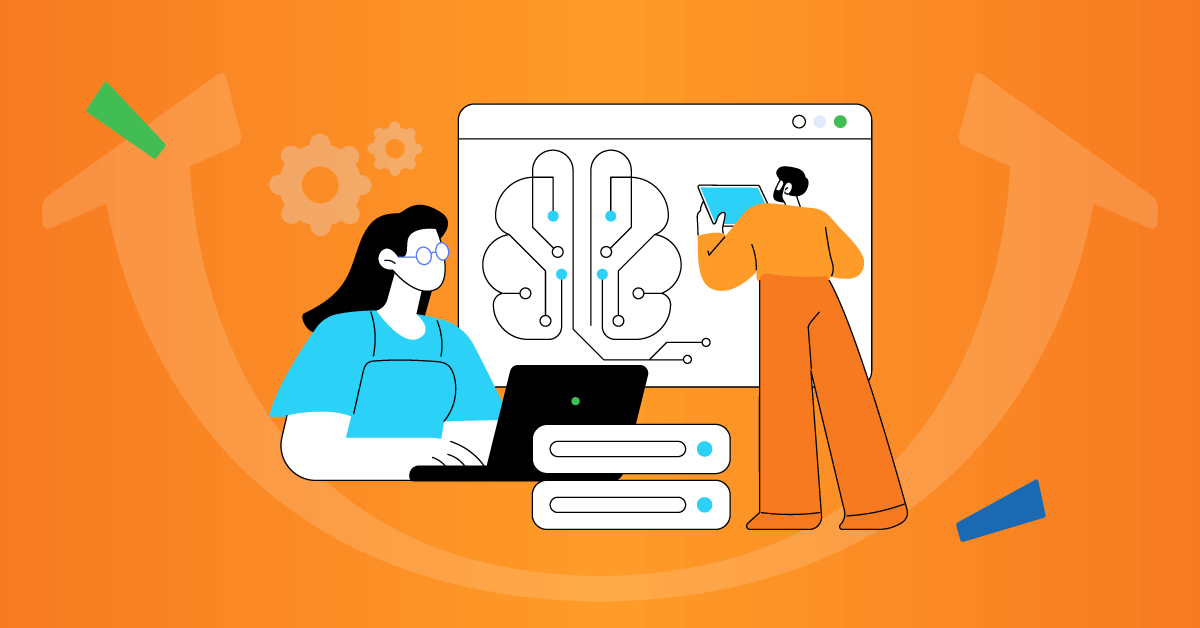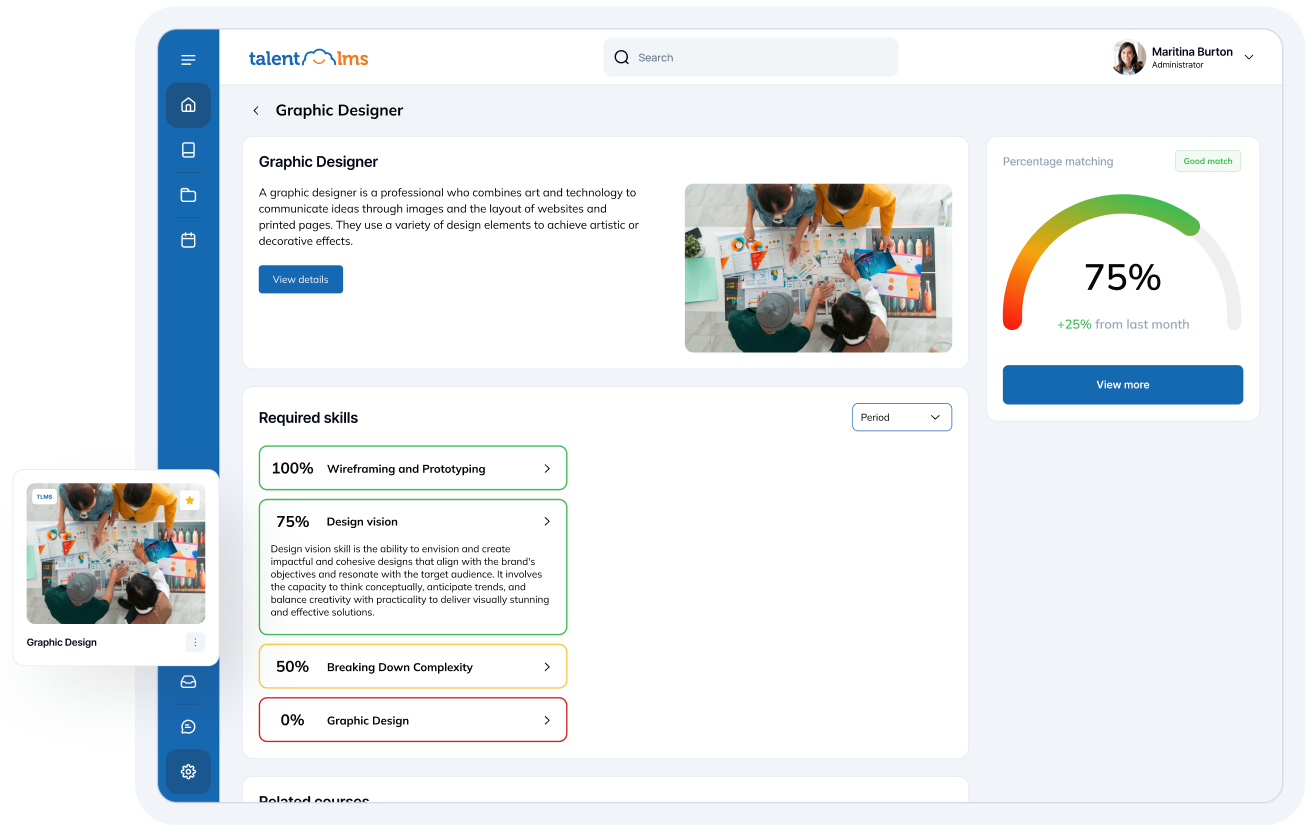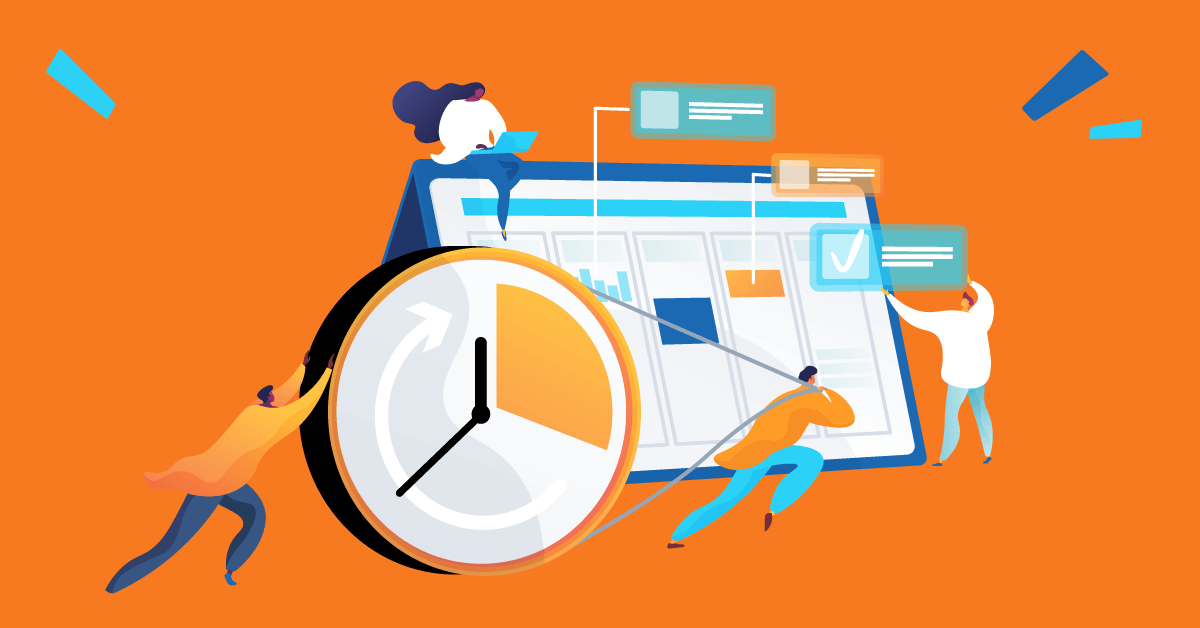- What is learning and development (L&D)?
- What are L&D interventions? (LDI)
- Why are learning and development programs important?
- What are common misconceptions about L&D and how do you tackle them?
- Examples of L&D programs
- 4 L&D best practices you should consider
- How do you identify L&D needs?
- What are the activities of L&D?
- Learning and development KPIs
- How to create a learning and development strategy
- Cultivate success through L&D
Let’s say you hire a team of world-class chefs for a massive event, but they only know how to cook with firewood. In a world now dominated by cooktops and ovens, that could be a problem.
They might be great, but they’re not equipped for today’s kitchen or your event. The same goes for your team.
Even the most talented people can start to fall behind if they don’t keep learning and developing. However, in a world where change is the only constant, keeping your workforce’s skills sharp can feel like an uphill battle.
But, here’s the good news: learning and development (L&D) is how you help hone your chefs’ (and employees’) skills to handle any challenges they might face or to become better at what they do. It’s about crafting a five-star meal of learning experiences that help your team grow, adapt, and shine.
What is learning and development (L&D)?
Learning and development is a strategic long-term plan to help employees improve their knowledge and skills. It includes many components that help employees learn new things, grow their skills, and do their jobs better.
Dr Keith Keating supports on Championing L&D’s true value: Making learning a business priority, from TalentLMS’ podcast series, Keep it Simple, that L&D experts don’t only focus on training. They need to understand business goals and align employee development with these objectives.
“Learning” and “development” are often used interchangeably. So is “training and education” in this context. But none of them are the same.
Learning involves gaining knowledge, skills, or attitudes through experiences, reading, or instruction.
Development helps employees do their current job better or prepares them for future challenges or responsibilities.
If employee training is about the present, development is about the future or long-term growth. It helps deepen an employee’s knowledge in a specific area by helping them master a skill over time. It can also help them expand their skills by guiding them to adjust to upcoming changes and challenges.
Employee development programs today are more holistic and refined. They help an employee grow professionally and personally—as opposed to simply benefiting the business. An example is a work-life balance development program to support employee well-being.
What are L&D interventions? (LDI)
The scope of L&D involves a diverse set of interventions.
Learning and development interventions (LDIs) refer to the various programs and initiatives designed to help you plan and manage employee development.
These interventions can take many forms, each serving a specific purpose and catering to different learning needs.
These are a few common types of LDIs:
- Skills gap analysis and competency mapping
- Learning needs assessments
- Career development plans
- Classroom and online training programs
- On-the-job training and mentoring
- Leadership development initiatives
- Soft skills development
- Knowledge management systems
- Learning paths
- Performance management and feedback loops
Why are learning and development programs important?
A while ago, there was a big talent gap in most companies. Everyone was looking for the most skilled employees, which bred a war for talent, as famously coined by Steve Harkin in 1997.
To overcome this, companies finally started looking inward at developing their employees. Shortly after that, they realized learning and development significantly impact the workplace and can substantially benefit the company.
Let’s review some key benefits:
Improved skill sets for a competitive advantage
L&D programs help you update or add new skills to your workforce to remain productive and thriving. This is often called upskilling and reskilling.
Both help employee development and professional growth while boosting business performance.
Focusing on career development and ongoing learning in this day and age better equips your teams for what lies ahead. And will ultimately give your business a competitive edge.
Increased productivity and decreased employee turnover
Well-designed L&D programs can significantly boost employee performance, and consequently, employee retention.
Dr. Keating highlights how L&D is crucial not only for developing employees but also for retaining top talent in the organization, “People are literally quitting their jobs because they don’t have the opportunity to grow and develop. So, who are the ones creating those developmental opportunities? We (L&D) are.”
Companies that understand the importance of training employees and deliver on it are more productive (17%), profitable (21%) and their employees are more likely to stay.
Develops future leaders
L&D programs can help businesses find and train employees who have the potential to become leaders in the company.
Having a solid group of leaders is key for keeping matters on track and aligning projects with business goals.
Attracts top talent
Organizations that focus on L&D are often more appealing to job seekers. It also helps to keep them since more than 90% of employees say they will stay at their jobs if they can learn and grow.
Reduces risks
L&D prevents problems and reduces risks for employees and the company.
One way it does this is through compliance training, which teaches employees about workplace safety rules.
Employees, particularly those likely to move into managerial positions, should also receive ethics training for professional development.
Improves customer satisfaction
In today’s market, people expect top-notch service, and businesses must deliver it flawlessly. Luckily, learning and development can positively affect the satisfaction of your customer base.
Well-trained employees are better equipped to understand and meet customer needs, leading to improved customer experiences and loyalty. Studies indicate that when a knowledgeable employee handles a customer’s request, it leads to a 16% increase in customer satisfaction.
What are common misconceptions about L&D and how do you tackle them?
There are several common misconceptions surrounding learning and development initiatives in organizations.
L&D is just about training sessions
The truth is that L&D consists of a broad scope of processes that often play out much like project management and venture planning and managing.
L&D professionals must be proactive and strategic, not just reactive, according to Dr. Keating. Meaning that effective L&D starts with analyzing the organization’s strategic goals and identifying the knowledge and skills required to achieve those goals. This analysis helps create targeted learning interventions to address skill gaps and equip employees with the necessary knowledge and abilities. When done right, those employees help to achieve business goals and drive the business’ ROI upward.
Then it’s about monitoring progress, tracking results, being updated on L&D trends, and adjusting programs, not to mention all the other processes involved.
L&D is a cost-center, not a revenue-generator
While L&D requires an upfront investment, it can lead to significant financial returns.
A skilled and engaged workforce drives better business performance, problem-solving, productivity, and customer satisfaction—all of which contribute to revenue growth.
Effective L&D also reduces costly employee turnover and improves operational efficiency.
Another point often taken for granted is how L&D can fuel innovation. Employees learn skills and knowledge to explore new ideas, techniques, and approaches. These can lead to the development of new products, services, or processes that create more profit or break markets.
L&D only benefits employees
Learning and development programs don’t just help employees. They also create a workforce that’s more skilled, flexible, and prepared for the future. As a result, it boosts the company’s performance and helps it reach its goals.
Results of L&D are hard to measure
Business leaders often worry that seeing the value of learning and development is hard. However, if you have the metrics, you can measure the impact and return on investment (ROI) of L&D programs quite accurately.
For example, organizations can track and analyze:
- Employee engagement scores. These often improve after successful L&D interventions.
- Employee retention rates. These should be on the rise due to L&D programs.
Performance improvements can also be measured through various means, such as:
- Skill assessments
- Project evaluations
- Customer satisfaction scores
- Task completion rates
Dr. Keating supports that L&D’s true impact often extends beyond traditional financial metrics and includes intangible benefits like employee growth and innovation, “A lot of what we do cannot be quantified from an ROI modeling perspective. […] So for me, it’s about value and impact: What value are we driving? What impact are we having?”
L&D is necessary only for new hires
Effective learning and development should be ongoing for all employees, regardless of their tenure or role—not limited to the onboarding process.
Continuous upskilling and reskilling efforts help organizations remain agile and adaptable in the face of AI developments and other events.

Meet TalentLibrary™
A growing collection of ready-made courses that cover the soft skills your teams need for success at work.![]()

Examples of L&D programs
Successful organizations know that investing in learning and development is an investment in themselves.
Amazon’s Career Choice Program
Amazon has a special program called “Career Choice”. This program funds employees who want to explore certificates, diplomas, or associate degrees in high-demand fields.
Employees can study any high-demand field they want, even if it differs from their current job at Amazon. Doing so supports employee growth and helps Amazon build a talent pipeline for various roles within the company.
Salesforce’s Trailhead
Salesforce’s “Trailhead” is a gamified online learning platform that offers a wide range of courses and certifications for employees and customers alike.
Gamification makes learning fun and interesting. Doing so motivates employees to want to keep learning new skills. The platform also gives learners badges and points when they complete tasks as an added motivator.
Deloitte’s Leadership Center for Inclusion
Deloitte’s Leadership Center for Inclusion is a specialized L&D program focusing on building inclusive leadership capabilities. It offers workshops, hands-on experiences, and online resources that help leaders learn about and deal with hidden biases.
They also help leaders build an inclusive team and create a workplace where different ideas are respected.
4 L&D best practices you should consider
Through trial and error, many best practices for L&D have emerged. Thankfully, these help guide companies to achieve L&D success.
1. Align L&D programs with business goals
When employee training programs link to company goals, every learning mile brings you closer to your vision. You can design courses that teach skills and drive performance, innovation, and growth in key business areas.
You can also align employee training with business success to create a win-win situation where employees thrive and the company soars.
2. Embrace blended learning approaches
Traditional classroom-based training methods are no longer needed. Your L&D should consist of blended learning approaches to drive engagement and results.
Not only do varied approaches help engage, but they carry unique benefits. For example, online training courses can help with the engagement of theoretical material, while role-playing and simulations can be helpful for the application of skills.
3. Use technology and digital tools
Use modern employee training software in your learning and development programs to make learning more exciting and fun. These tools can also track progress and see if the program is working.
For example, consider using:
- Learning management systems (LMS) to organize, deliver, and track training programs.
- Virtual reality (VR) simulations to offer immersive learning experiences, especially for complex tasks.
- Gamification elements to add game-like features to learning modules, making them more engaging.
- Mobile learning apps to allow employees learn on the go.
4. Encourage continuous learning and development
Learning and development should be a continuous improvement process rather than a one-time event.
To keep them learning and growing, give employees chances to learn on their own via online courses, webinars, and platforms. Doing so can help them feel like they can take charge of their own professional development.
How do you identify L&D needs?
Identifying L&D needs is one of the early steps in the whole L&D process. Here you are going to look beyond just skills gaps but at many aspects of the entire business ecosystem while keeping the goals of the business in mind.
If you skip this step, you might waste time and resources on programs that don’t fix the real problems.
- Skills gap analysis: helps you find skills that are important to your staff and where they are lacking.
- Performance appraisals: offers insights into an employee’s strengths, weaknesses, and areas for improvement.
- Organizational needs assessment: determines what skills and knowledge the organization needs to reach its goals.
- Employee surveys and feedback: identifies perceived training needs, areas of interest, and developmental aspirations.
- Job task analysis: breaks down specific job roles into their component tasks to identify the knowledge, skills, and abilities required to perform those tasks effectively.
- Observation and monitoring: helps see where additional training or support is needed.
What are the activities of L&D?
Learning and development activities are the things employees do to improve their skills and knowledge. These activities are part of a bigger learning and development plan and interventions. L&D activities are focused, tactical efforts that help the organization achieve its learning and development goals.
A few common types of L&D activities that enhance employee development include:
- Performance management
- Employee growth
- Skill development
- Succession planning
- Training courses
- Onboarding
- Leadership training
- Change management
Learning and development KPIs
Data helps managers, businesses, and HR teams make decisions based on numbers and facts. With good data in hand, you can improve processes like L&D.
In the context of L&D, KPIs (Key Performance Indicators) are like scorecards that show how well employee learning is going.
While data is gold, gathering and analyzing it may not seem that glamorous. Knowing which metrics to track and the formula for each metric can also be tricky.
To solve both of these issues, you can use an LMS. It keeps track of all the important metrics you need (in real-time) and displays them in an easy-to-digest dashboard that you can refer to instantly.
Some of the metrics you will likely need to know are:
- Training completion rates track the percentage of employees who have completed a training program.
- Knowledge retention rates measure how much information employees retain after completing training.
- Employee engagement levels gauge how engaged employees are with the training.
- Performance improvements are tracked through skill assessments and performance reviews before and after training.

How to create a learning and development strategy
Every organization has unique L&D needs, so generic training won’t suffice. To get the most out of L&D, companies should create a learning and development program tailored to their requirements.
With that in mind, let’s take a high level view at how to create a learning and development strategy.
1. Define organizational goals
First, you must deeply understand your company’s short and long-term goals. Doing so helps you align your L&D efforts with the business strategy.
2. Conduct a skills gap analysis
Identify the skills and competencies required to achieve your organizational goals with a skills gap analysis.
3. Set learning objectives
Next up, you’ll set specific, doable learning objectives that match the skills needed and the people you’re aiming to help. Connect these goals with what the organization wants to achieve.
4. Choose delivery methods and plan content
Different learning methods have different effects, benefits, and drawbacks. Using a varied but strategic approach here is going to serve everyone involved best.
To get the most out of your training program, you should think about personalized learning to boost engagement and knowledge retention.
5. Develop content and materials
Here, you will want to work with instructional designers to create engaging and helpful training materials.
6. Implement, manage, refine, and measure
The last step actually consists of a few steps. Let’s have a look:
- Create a continuous learning and development culture—getting people ready to learn.
- Track initiative effectiveness through feedback, assessments, and performance metrics.
- Adapt your L&D strategy to changing business and employee needs.
- Set metrics to measure your L&D initiatives’ ROI.
Cultivate success through L&D
Learning and development isn’t just a box to tick off—it’s a proven way to turn a good team into a great one. And it’s a way to ensure employee retention and business performance. Sure, the benefits might not be instant, but the long-term gains and ROI are well worth it.
Think of it like long-term investment in your company’s future. One that means you’re not just keeping up with the competition—you’re setting the pace.
| Tags: L&D,learning and development






